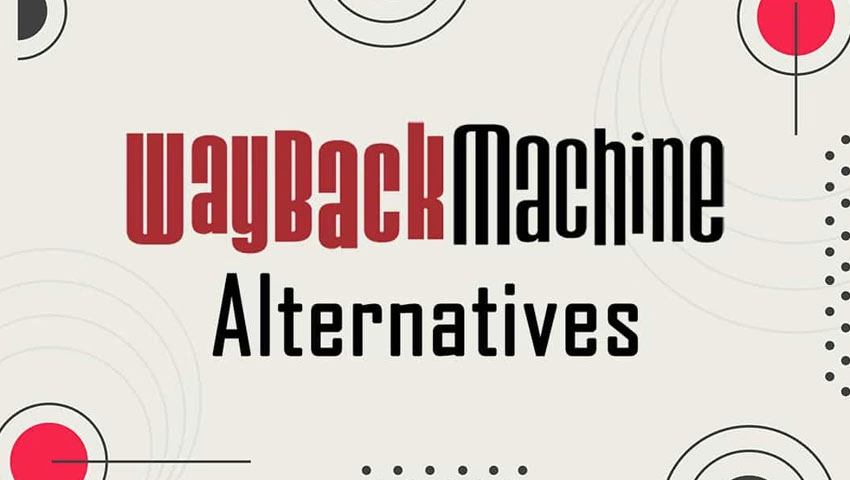How amazing would it be if you could see how your competitor’s website looked in the past and what changes they have made to it?
Is that possible?
Yes, it is possible with the help of the Wayback Machine. It is a digital archive that will allow you to go back in time to see how websites looked in the past. It is the best way to study and analyze your competitors if you have complete control over their online presence.
Created in 1996 by Brewster Kahle and Bruce Gilliat, it provides access to all knowledge by preserving archived copies of defunct web pages. Since its launch, Wayback Machine has successfully achieved more than 916 billion web pages and well over 100 petabytes of data.
In this article, we’ll take a closer look into Wayback Machine working and its alternatives.
How Does Wayback Machine Work?
It is very easy to understand the workings of the Wayback Machine. Think of it as the largest online library, where tons of copies of websites from different times are saved. You just have to enter the website address in the required box and press enter.
Now, you can see how a website looked like in the past and what changes they have made. It will show you a calendar with all dates. After clicking a date, you will be able to see how the site appeared on that particular date.
It will also provide other details, such as changes, collections, summaries, site maps and URLs. In the changes section, you can see what changes a website has made on a particular date.
How amazing is it?
Wayback Machine has saved more than 916 million web pages. But it is still a big question whether it has every page or update made to the site.
6 Best Alternatives to Wayback Machine
1. WebCite

WebCite is not a complete alternative to Wayback Machine. It is an archive site like it, specially designed to preserve scientific and educationally important material. It takes screenshots of the content as they existed at the time when a blogger quoted from it.
That is why the website is widely used by authors, journalists, academics and publishers. One drawback of the website is that it doesn’t take new requests at the time of publishing. You can access already archived pages only.
If the website ever starts accepting requests in the future, it will become the most powerful tool that will allow you to upload a manuscript directly to the website. Then the tool will automatically create archives of every uploaded manuscript, saving you a lot of time.
Since its launch, WebCite has gone offline several times for a lengthy period of time, without any explanation.
2. Memento Time Travel

Memento Time Travel will allow you to access archives from several sources, giving you a customizable experience. The website comes with a Chrome extension feature that will allow you to select the date on which you want to view your current page.
So, you don’t have to waste time entering the URL again and again. The best thing about Memento Time Travel is that it allows you to create a snapshot of a page and generate a link that will not break.
3. Archive.today

Archive.today is another best alternative to Wayback Machine, due to its snapshot tool that will allow you to save a link to a page as it existed. The website comes with an easy-to-use interface, where you can effortlessly preserve content and generate unalterable links to the archived versions.
One best thing about Archive.today is that it will allow you to perform advanced search queries on domains and URLs to find snapshots that have been saved with the tool.
4. Pagefreezer

If you’re looking for a web archiving solution tailored for businesses, needing to meet compliance or legal standards, there is no better platform than Pagefreezer. It is considered the safest site on this list, offering real-time archiving of websites, social media and enterprise communications.
Pagefreezer is best for industries with strict regulations as it accurately preserves all the content. One key feature of a website is its ability to critically record web content. This feature is useful in legal cases, where authenticity is important.
5. Perma.cc

Widely used in universities, libraries and legal institutions, Perma.cc is an archiving site that will allow you to create permanent, unchangeable links to web pages. It has the ability to preserve content exactly as it appeared at the time it was archived.
Originally, Perma.cc was created to address the issue of link rot. One best things about the website is that it will allow you to generate a stable link that redirects to a saved, archived page, maintaining the integrity of scholarly and legal references.
6. Stillio

If you want to capture automated website screenshots every day, hour, week, or month, Stillio is the best site to choose from. As a marketer, it will be your best choice, helping you to track changes on your competitor’s web pages over time.
The best thing is that Stillio will allow you to customize the frequency and format of snapshots. You can archive content in different formats, like PDF.
How to Choose the Right Web Archive Site?
With so many options available, it becomes difficult to choose the right one. Here are some key factors to consider when choosing the right web archive site;
- Know your Purpose:- First, you need to know your purpose when choosing an archiving site. If you’re looking for a website for legal and academic archiving, you can go with Perma.cc or WebCite. These sites are designed to prevent link rot and ensure citation accuracy.
- Ease of Access:- You have to evaluate the platform’s interface and usability. Make sure the website offers simple navigation for saving and retrieving archived pages.
- Customizability:- Make sure to choose a website that allows you to create personalized repositories of archived content. It will provide more control over what is preserved.
- Frequency of Updates:- If you have a business that requires frequent records for monitoring purposes, you need archiving sites, like Stillio or Pagefreezer.
- Technical Support:- You have to evaluate the level of customer support, including availability of tutorials, FAQs, and live assistance.
Frequently Asked Questions
1. Are Wayback Machine Alternatives Free to Use?
The majority of them are free but might include some paid functionalities.
2. Can I Archive My Website?
Yes, most of these tools enable archiving of your own website.
3. Do these Alternatives Support Multimedia Content?
Some of them support archiving multimedia, images, videos, and dynamic content.
4. Can I See Deleted or Inaccessible Pages Using these Tools?
Yes, with tools like Archive.today and PageFreezer, you can view deleted or unavailable web pages, depending on the coverage.
5. Do I Need Technical Knowledge to Use these Wayback Machine Alternatives?
Most of the platforms are user-friendly, and minimal technical knowledge is required to use these sites.
Wrapping Up
Choosing the right alternative to the Wayback Machine depends on your specific needs. Whether you’re looking for a tool to archive your own website, access historical snapshots, or monitor changes on competitors’ sites, there’s an option for you.
Platforms like Archive.today offer simplicity, while others like Perma.cc cater to academic and legal use. For businesses, tools such as Stillio provide tailored features for tracking changes over time.
Every alternative has its own advantages, so the decision should be made based on the ease of use, features, and pricing. With the right tool, you can easily preserve and access web history to keep you well-prepared.












